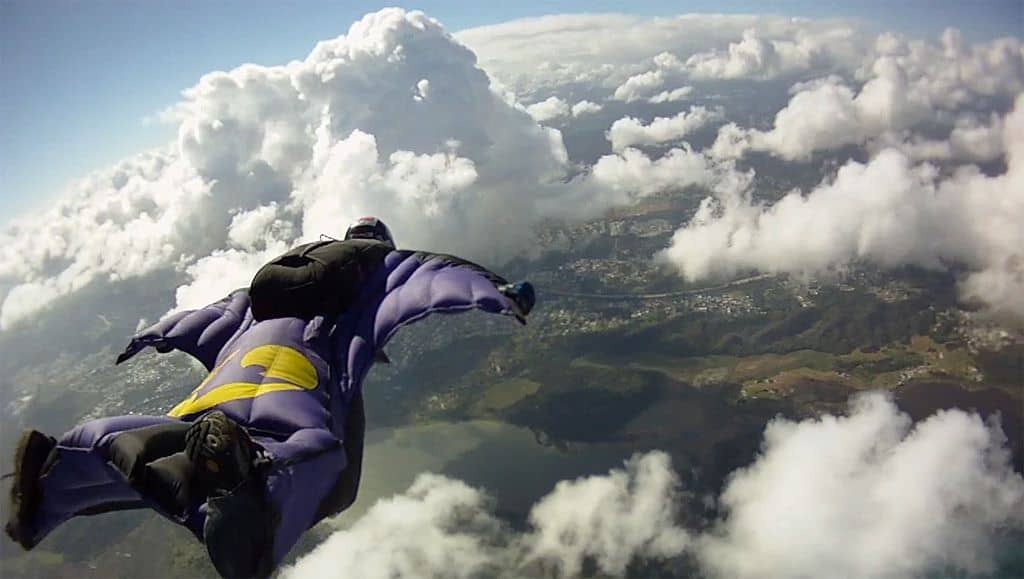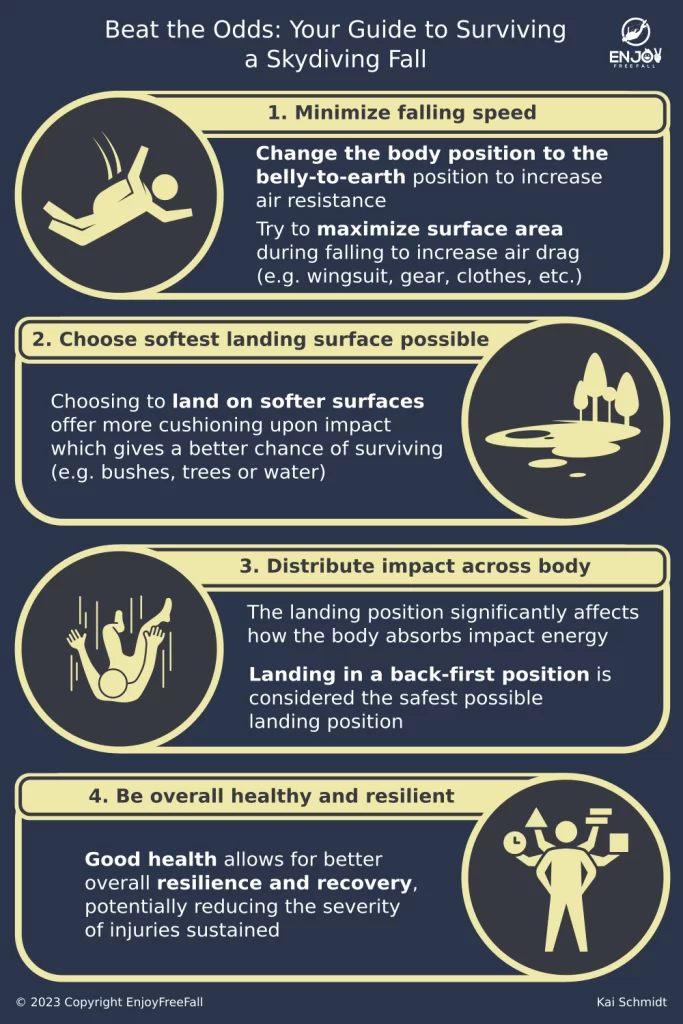
Daredevil wingsuit flyers captivate us with their astonishing flights, defying gravity and death as they soar through the skies and through mountain valleys. Watching the videos always makes us wonder, what happens if they crash? And has anyone survived a wingsuit crash?
There are skydivers who survived a crash with wingsuits, despite the low odds of surviving it. In total, there are 7 recorded cases where people survived a wingsuit crash. As not all incidents are reported, the actual number might be higher.
In this blog post, we celebrate the stories of three of these aerial enthusiasts, each of whom has brushed shoulders with death yet remains steadfast in their love for soaring through the skies. Their stories are not solely about peril; they are tales of resilience, ingenuity, and an indomitable passion for life and flight.
How to Survive a Wingsuit Crash
There are several factors that play a role in surviving a wingsuit crash. Wingsuit flyers should maximize their surface area during freefall, aim for a softer ground surface like bushes or water, and adopt a back-first landing position to reduce the significance of ground impact.
In order to understand the role of each factor, let’s look at them one by one:
- Falling Speed Impact: Falling speed directly affects the force of impact upon landing. Higher speeds result in greater kinetic energy upon impact, leading to more severe injuries. Slower falling speeds allow for a better chance of surviving the impact.
The exit altitude only plays a role until 1,500ft (460m) as terminal velocity is reached afterward. After reaching terminal velocity, any increase in altitude does not lead to a significant increase in falling speed. This means that the falling speed stabilizes at a level where air resistance matches gravity’s pull, making jump height less impactful on falling speed beyond a certain point. - Surface Area: The surface area of the wingsuit flyer affects air resistance. A larger surface area creates more drag against the air, slowing down the fall. By increasing their surface area, wingsuit pilots can counteract the acceleration caused by gravity and reduce their impact speed.
- Ground Surface: The ground surface plays a pivotal role in absorbing impact energy. Softer surfaces, like bushes, trees, or water, offer more give upon impact, increasing the time over which deceleration occurs. This reduces the abruptness of the impact force, thereby lowering the likelihood of severe injuries.
- Safe Landing Position: The landing position of wingsuit pilots significantly affects how the body absorbs impact energy. Landing head-first or feet-first concentrates the impact force on a smaller area, leading to catastrophic injuries due to the concentrated force on the head or legs. The back-first or belly-first position distributes the force across a larger area, slightly increasing the chances of surviving the impact.
- Healthiness: Overall healthiness, flexibility, and strength contribute to a body’s ability to absorb and recover from impact. Strong bone structures resist fractures and distribute impact energy more effectively. Good health allows for better overall resilience and recovery, potentially reducing the severity of injuries sustained during impact.
Three Survival Stories of Wingsuit Crashes
Let’s explore the exciting yet terrifying stories of those who defied the odds and survived wingsuit experiences that pushed the boundaries of human resilience. Who has survived a wingsuit crash?
Eric Dossantos Crashed and Learned From His Overconfidence
Eric is a military member from San Diego who went into skydiving at the age of 26. When he first watched a video of wingsuit flying, he knew he wanted to do the same. He rushed through the requirements and amassed 300 skydives within a year. He, then, delved into BASE jumping after a BASE First Jump Course, ultimately accumulating 105 wingsuit BASE jumps alongside his 900 total skydives and 550 wingsuit flights.
Even though the progress of Eric is fascinating he was still a relative novice of wingsuit base jumping. In the summer of 2016, he made a trip to France to do several wingsuit jumps. During his second jump of the day from Aiguille du Midi in Chamonix, Eric aimed for the familiar Cheese Grater line, which he had flown before.
However, his misjudgment of altitude and speed due to overconfidence led to a fatal stall as he crashed into the trees. Remarkably, when he realized the impending crash, Eric did not react by flinching, bracing for impact, or adjusting his body position. Despite his limited skill level and knowledge, he instinctively maintained his flying position, believing it offered the best chance of survival during the impact on the trees.
This event made him place a newfound emphasis on training and skill over shortcuts. Despite considering wingsuiting again, Eric quit BASE jumping altogether. His story encourages perseverance and underlines the vital importance of safety, choosing the right body position during the crash, and working together with mentors – which Eric never really did.
Even though Eric was in the military, he did not learn wingsuit flying in his military training. If you want to learn more about the use of wingsuits in the military make sure to check out my article about whether special forces use wingsuits.
Jeb Corliss Continues Wingsuit Flying Despite His Crash
Jeb Corliss is an accomplished American professional skydiver and BASE jumper, born on March 25, 1976. Known for his daring feats, he has leaped from iconic landmarks such as the Eiffel Tower in Paris, the Space Needle in Seattle, Christ the Redeemer statue in Rio de Janeiro, and the Petronas Twin Towers in Kuala Lumpur.
In 2012, Corliss attempted a wingsuit jump from Table Mountain in Cape Town, South Africa. During the jump, wind arose and Corliss flew too close to the mountain. Even though he activated his emergency parachute, Corlis crashed into the mountainside, leading to a double leg fracture. Despite the impact, he managed to survive the accident
I know 100 percent that this sport is going to kill me. That makes me take it very seriously
Jeb Corliss
Corliss continued to do wingsuit base jumps after his accidents, and has been a motivational speaker since. Corliss is also known due to his proximity flight through the peaks of Mount Jianglang. To learn more about stunts such as these, make sure to read my article about the 13 most amazing wingsuit stunts ever performed. Trust me, it is the best thing you will see on the internet today!
Lassi-Pekka Ruuskanen Continued Jumping Only Weeks After His Recovery
In June, while wingsuit flying in Turkey, Ruuskanen suffered a severe accident that resulted in a broken left arm and pelvis. This accident was significant enough to leave him requiring the use of a wheelchair for a six-week recovery period. Despite the severity of his injuries, the incident did not deter Ruuskanen from the sport entirely.
However, it served as a stark warning sign for him, prompting a period of reflection on the risks involved and the importance of recognizing and respecting personal limits to prevent future accidents. Ruuskanen’s experience underlines the critical importance of self-awareness in extreme sports, as he notes that everyone makes mistakes, so understanding one’s own capabilities is essential.
I personally find it quite inspirational and a little bit crazy, that Ruuskanen went back to wingsuit flying after the recovery. If you also wonder about this make sure to read my article about why people fly wingsuits. It sheds some light on the psychology of wingsuit pilots.
How Many Wingsuit Deaths Have There Been?
In total, there have been approximately 183 reported fatalities associated with wingsuit use since 1996. However, this number could potentially be greater due to the likelihood of unrecorded incidents. With 25 fatalities, 2016 has been the year with the most recorded wingsuit deaths.
If you are interested in understanding more about the dangers of wingsuit flying, make sure to read my article about how dangerous is wingsuit flying really. It reveals some common misconceptions about wingsuit flying.

Could You Survive Jumping Out of a Plane in a Wingsuit?
It is theoretically possible to survive jumping from a plane with only a wingsuit and not a parachute. There are skydivers and wingsuit pilots that have survived a jump where the parachute did not deflate. In practice, however, the chances of survival are extremely low.
If you are interested in learning how many people have survived a double parachute malfunction, make sure to read my article about the 9 most fascinating survival stories of a dual parachute malfunction.
Will Wingsuit Flying Become Safer in the Future?
Wingsuit flying has the potential to become safer in the future due to advancements in equipment and the potential for increased regulations. New developments such as tandem wingsuit flying, indoor wingsuit flying, and flight simulators provide safer alternatives and training options.
However, the increasing popularity of wingsuit flying, fueled in part by internet fame and the desire for extreme stunts, poses a challenge to enhancing safety. As more people are drawn to the sport, there may be a greater number of inexperienced or reckless individuals pushing boundaries and taking risks, which could lead to more accidents.
Thus, the future safety of wingsuit flying will likely depend on a balance between advancements in technology and training, regulatory measures, and the behavior and decision-making of the individuals involved in wingsuit flying.
Last but not least, do you know what occurs in the event of a wingsuit flying accident? If not, read my article about how investigates skydiving accidents. The answer might surprise you!
That being said, enjoy your free fall!
Photo Credits
Richard Schneider from Los Angeles, CC BY 2.0 <https://creativecommons.org/licenses/by/2.0>, via Wikimedia Commons, resized

